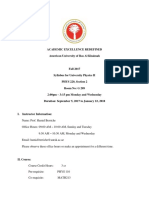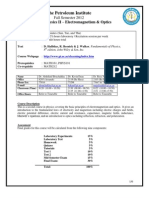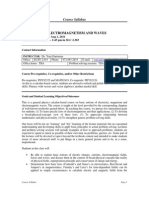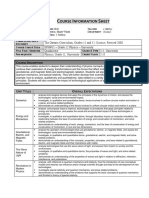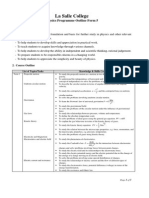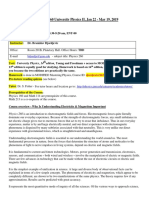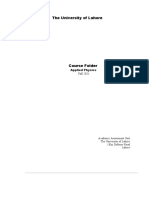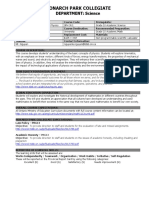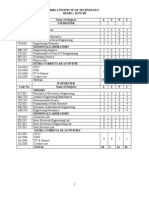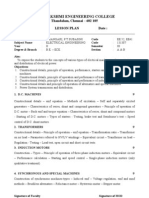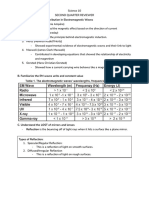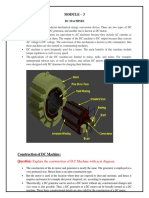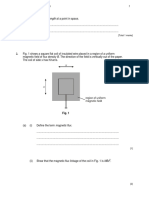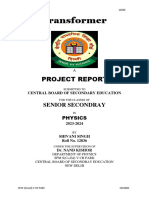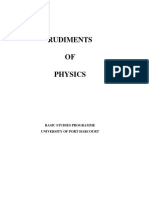Department of Computer Science & IT
The University of Lahore
Course Outline
PHY-01115: APPLIED PHYSICS (Summer -2022)
Credit Hours 3+0
Co-requisite (s) None
Pre-requisite(s) None
Course Type Core for BSCS
Weekly Tuition Pattern 2 session lectures (90 min each)
Course Instructor Urram Shahzad
1- Course Description
The applied physics course focuses on the basic physics that underlies most developments in
computational and mathematical tools that are important to both physicists and computational scientists.
The applied physics curriculum offers students the skills, experience and preparation necessary for several
career options.
2- Objectives
Upon successful completion of the course, a student should be able to:
Build an understanding of the fundamental principles underlying physical phenomenon.
Develop the ability to describe the physical phenomenon verbally and mathematically.
To learn problem solving skills and critical thinking, including real life problems and application
of calculus to the solution of physics problems.
3- Outcomes
Students who successfully complete the course are supposed to be able to:
Apply fundamental computing theories, design and development models and methodologies to
the systems for the people.
Work in different research areas related to the domain of HCI, e.g., accessibility, ubiquitous
computing etc.
Design and develop user interfaces for people with disabilities and older adults.
4- Course Structure
1. Numerical problems related to physical phenomenon.
2. Class Activities (case studies using theoretical and practical tools and techniques)
3. Assignments
4. Quizzes (Surprised/Announced)
Page 1 of 5
Dept. of CS&IT
�5- Course Duration
This course will be held twice a week of 1.5 hours class duration.
6- Course Style
The course will be delivered in a classroom environment.
7- Additional Course Requirement
In addition to the objectives of this course, students are expected to gain skills to study and
analyze real life problems and solve them strategically, and also apply these skills in other fields.
8- Text and Other Resources
8.1 Reference Text
1- Fundamentals of Physics, 10thedition by Halliday, Resnick, Walker.
8.2 AuxiliaryMaterial
1- University Physics, 11th edition by Sears and Zemansky
2- Physics for Scientists and Engineers 6th edition by Serway and Beichner
9- Course Outline
The lecturers are supposed to complete the following topics/sub-topics before the mid/final term
examination as prescribed in the course outline below:
Course Outline Plan
Coulomb’s Law
Lecture 1 Introduction to physics, charge, conservation of charge,
Week 1: quantization of charge and related problems.
Conductor, semiconductors and insultors I n term of bandgap
Lecture 2
theory, induction of charges.
Lecture 3 Coulomb’s Law, its applications and related problems
Week 2: Electric Field Chapter no. 22
Lecture 4
Electric field , electric field lines, and sample problems
Finding the electric due to a point charge, due to electric dipole
Lecture 5
and related sample problems.
Week 3:
Finding the electric due to a ring of charge, Finding the electric
Lecture 6 due to a curved path, and sample problems
Lecture 7 Finding the electric due to a disk of charge and sample problems
Week 4: Gauss’s Law Chapter no. 23
Lecture 8 Introduction to Electric flux, and gauss’s law and related problems
Relation between coulomb’s law and Gauss’s law and related
Lecture 9
Week 5: problems.
Applying Gauss’s Law: cyliderical symmetry and related
Lecture 10
problems
Week 6: Lecture 11 Applying Gauss’s Law: planar symmetry and related sample
Page 2 of 5
Dept. of CS&IT
� problems
Applying Gauss’s Law: spherical symmetry and related sample
Lecture 12
problems
Potential Energy and Conservation of Energy Chapter no. 24
Potential Energy, Work and Potential Energy Relation,
Lecture 13
Gravitational Potential Energy, Elastic Potential Energy
Week 7:
Assignment -1b
Equipotential surfaces and and electric fields, related problems.
Lecture 14
Quiz 02 (30 min)
Calculating potential from the Electric field,and related sample
Lecture 15 problems
Week 8:
Revision of all mid term cources, related problems and quries
Lecture 16
quarries
Week 9 Mid Term Exam
Electric current Chapter no. 26
Lecture 17 Electric current, electric circuit, directions of current and related
Week 10:
problems.
Lecture 18 Current density and related problems.
Lecture 19 Resistance and resistivity, Ohm’s law and related problems.
Week 11: A Microscopic view of Ohm’s law and its related sample
Lecture 20
problems Assignment -2a
Electric current Chapter no. 28
Lecture 21
Magnetic field, production of magnetic field, related problems,
Week 12: Magnetic field due to a current, Magnetic field due to a current in
Lecture 22 a straight wire, Magnetic Field Due to a Current in a Circular Arc
of Wire.
Force Between Two Parallel Currents, Ampere’s law and related
Lecture 23
problems.
Week 13:
Applications of Ampere’s law SOLENOIDS AND TOROIDS
Lecture 24
Quiz 03 (30 min)
Induction and inductance Chapter no. 30
Lecture 25 Faraday’s experiments, Faraday’s Law of Induction, Lenz’s
Week 14:
law, and related problems
Lecture 26 Induced electric field, Induction and Energy Transfers.
Electromagnetic Waves Chapter no. 33
Week 15:
Lecture 27 Reflection and refraction, and related problems
Assignment -2b
Lecture 28 Total internal reflection, and related problems
Polarzation of electromagnetic waves, polarized light.
Lecture 29
Week 16: Quiz 04 (30 min)
Lecture 30 Polarzation of sheet and related problems ,
Final Exam
Page 3 of 5
Dept. of CS&IT
�10- Assessment Criteria
No. Assessment Percentage
1. Quizzes 15%
2. Assignments 10%
3. Mid term Examination 25%
4. Final Examination 50%
Total 100%
11- Attendance Requirements
You are expected to attend all lectures, seminars, tutorials, and lab sessions or any other
classroom activity announced. Where you fail to attend classes, you cannot expect the lecturer to
brief you on what you have missed. You are responsible for your attendance, not the academic
staff. Attendance at tutorials and lab sessions will be strictly monitored, and failure to attend will
be taken into account.
Note:Minimum of 75% Attendance in lectures/lab sessions/seminars (if any) are required for a
student to sit in the Final-Term examination.
Etiquette: Please keep all cell phones turned OFF during class. If your activities during class are
deemed disruptive, you will be asked to leave.
12- Submission and Collection of Assignment
All assignments should be handed in at the beginning of the class sessions when they are due. All
assignments may be handed back during scheduled classes. Online Assignment will be submitted
on slate.
13- General Information
Students are required to be familiar with the university code conduct, and to abide by its terms
and conditions.
13.1 Academic Misconduct
Please refer to the Code of Conduct for definitions and penalties for Academic Misconduct,
plagiarism, collusion, and other specific acts of academic dishonesty. Academic honesty is crucial
to a student's credibility and self-esteem, and ultimately reflects the values and morals of the
University as a whole. A student may work together with one or a group of students discussing
assignment content, identifying relevant references, and debating issues relevant to the subject.
Academic investigation is not limited to the views and opinions of one individual, but is built by
forming opinion based on past and present work in the field. It is legitimate and appropriate to
synthesize the work of others, provided that such work is clearly and accurately referenced.
Plagiarism occurs when the work (including such things as text, figures, ideas, or conceptual
structure, whether verbatim or not) created by another person or persons is used and presented as
one’s own creation, unless the source of each quotation or piece of borrowed material is
Page 4 of 5
Dept. of CS&IT
� acknowledged with an appropriate citation. Encouraging or assisting another person to commit
plagiarism is a form of improper collusion and may attract the same penalties. To prevent
Academic Misconduct occurring, students are expected to familiarize themselves with the
University policy, the Subject Outline statements, and specific assignment guidelines. Students
should also seek advice from Subject Leaders on acceptable academic conduct.
13.2 Guidelines to Avoid Plagiarism
Whenever you copy more than a few words from any source, you must acknowledge that source
by putting the quote in quotation marks and providing the name of the author. Full details must be
provided in your bibliography. If you copy a diagram, statistical table, map, etc., you must
acknowledge the source. The recommended way is to show this under the diagram. If you quote
any statistics in your text, the source should be acknowledged. Again full details must be
provided in your bibliography. Whenever you use the ideas of any other author you should
acknowledge those, using the APA (American Psychological Association) style of referencing.
Students are encouraged to co-operate, but collusion is a form of cheating. Students may use any
sources (acknowledged of course) other than the assignments of fellow students. Unless your
Subject Leader informs you otherwise, the following guideline should be used: Students may
work together in obtaining references, discussing the content of the references and discussing the
assignment, but when they write, they must write alone.
14- General Approval
Checked by, Approved by,
Page 5 of 5
Dept. of CS&IT









